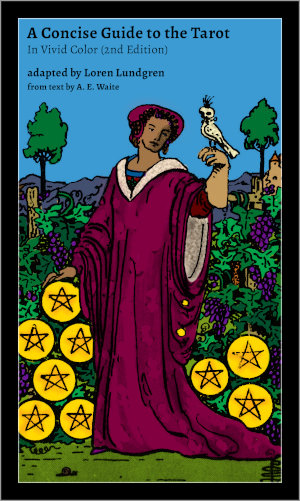Tarot Reading Will I get the TV producer job?
Reading Performed 03/21/2013 at 6:19 PM
Click or scroll down for the meaning of each position and the interpretation of its card.
Visual Layout
The Meanings of these Tarot Cards
Past
What has already occurred; the past.
The Tower from the Waite Smith Tarot Deck
Card Meaning When Upright
Misery, distress, indigence, adversity, calamity, disgrace, deception, ruin. It is a card in particular of unforeseen catastrophe.
A. E. Waite's Secondary Meanings
The Tower struck by Lightning. Its alternative titles are: Castle of Plutus, God's House and the Tower of Babel. In the last case, the figures falling therefrom are held to be Nimrod and his minister. It is assuredly a card of confusion, and the design corresponds, broadly speaking, to any of the designations except Maison Dieu, unless we are to understand that the House of God has been abandoned and the veil of the temple rent. It is a little surprising that the device has not so far been allocated to the destruction Of Solomon's Temple, when the lightning would symbolize the fire and sword with which that edifice was visited by the King of the Chaldees.
Card Description
Occult explanations attached to this card are meagre and mostly disconcerting. It is idle to indicate that it depicts min in all its aspects, because it bears this evidence on the surface. It is said further that it contains the first allusion to a material building, but I do not conceive that the Tower is more or less material than the pillars which we have met with in three previous cases. I see nothing to warrant Papus in supposing that it is literally the fall of Adam, but there is more in favour of his alternative--that it signifies the materialization of the spiritual word. The bibliographer Christian imagines that it is the downfall of the mind, seeking to penetrate the mystery of God. I agree rather with Grand Orient that it is the ruin of the House of We, when evil has prevailed therein, and above all that it is the rending of a House of Doctrine. I understand that the reference is, however, to a House of Falsehood. It illustrates also in the most comprehensive way the old truth that "except the Lord build the house, they labour in vain that build it." There is a sense in which the catastrophe is a reflection from the previous card, but not on the side of the symbolism which I have tried to indicate therein. It is more correctly a question of analogy; one is concerned with the fall into the material and animal state, while the other signifies destruction on the intellectual side. The Tower has been spoken of as the chastisement of pride and the intellect overwhelmed in the attempt to penetrate the Mystery of God; but in neither case do these explanations account for the two persons who are the living sufferers. The one is the literal word made void and the other its false interpretation. In yet a deeper sense, it may signify also the end of a dispensation, but there is no possibility here for the consideration of this involved question.
Related Posts
Present
What is occurring now; the present.
Future
What has not yet occurred; the future.
The Hanged Man from the Waite Smith Tarot Deck
Card Meaning When Upright
Wisdom, circumspection, discernment, trials, sacrifice, intuition, divination, prophecy.
A. E. Waite's Secondary Meanings
The Hanged Man. This is the symbol which is supposed to represent Prudence, and Eliphas Levi says, in his most shallow and plausible manner, that it is the adept bound by his engagements. The figure of a man is suspended head-downwards from a gibbet, to which he is attached by a rope about one of his ankles. The arms are bound behind him, and one leg is crossed over the other. According to another, and indeed the prevailing interpretation, he signifies sacrifice, but all current meanings attributed to this card are cartomancists' intuitions, apart from any real value on the symbolical side. The fortune-tellers of the eighteenth century who circulated Tarots, depict a semi-feminine youth in jerkin, poised erect on one foot and loosely attached to a short stake driven into the ground.
Card Description
The gallows from which he is suspended forms a Tau cross, while the figure--from the position of the legs--forms a fylfot cross. There is a nimbus about the head of the seeming martyr. It should be noted (1) that the tree of sacrifice is living wood, with leaves thereon; (2) that the face expresses deep entrancement, not suffering; (3) that the figure, as a whole, suggests life in suspension, but life and not death. It is a card of profound significance, but all the significance is veiled. One of his editors suggests that Eliphas Levi did not know the meaning, which is unquestionable nor did the editor himself. It has been called falsely a card of martyrdom, a card a of prudence, a card of the Great Work, a card of duty; but we may exhaust all published interpretations and find only vanity. I will say very simply on my own part that it expresses the relation, in one of its aspects, between the Divine and the Universe. He who can understand that the story of his higher nature is imbedded in this symbolism will receive intimations concerning a great awakening that is possible, and will know that after the sacred Mystery of Death there is a glorious Mystery of Resurrection.







.jpg)
